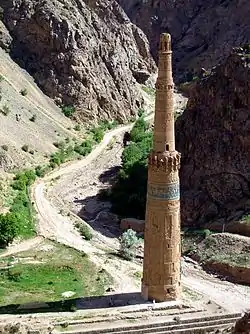Firozkoh
Firozkoh (Persian: فیروزکوه, Fīrōzkōh), or Turquoise Mountain, is the lost capital of the Ghorid dynasty, in the Ghor Province of central Afghanistan. It was reputedly one of the greatest cities of its age, but was destroyed by Tolui, son of Genghis Khan, in the early 1220s after a siege and lost to history. Firozkoh was used as a summer capital, as the leadership of the Ghorid sultanate were semi-nomadic.[1]

It has been proposed that the Minaret of Jam, in Shahrak District, Ghor Province, is the only standing remains of the city.[2] It is also believed that the ancient city was the home of a Jewish trading community, documented by inscriptions on tombstones found in the 1950s. The scholar Walter Fischel published an article reviewing the finds and establishing the connections of the Firozkoh community with other Jewish communities in early Medieval Afghanistan.[3]
New Discoveries
With the War in Afghanistan in 2001, the Taliban's hold on ancient places was broken, leaving the Ghor Province open to pillagers. Therefore, after the invasion, hundreds of diggers flocked to the Minaret to uncover lost gold. When visited by Rory Stewart in 2002, the remains of the city had been heavily damaged by looters, and many of the treasures that were in the city have now been sold in markets in Herat, Kabul, and Tehran.[4]
See also
References
- Thomas, David (2007). "Firuzkuh: The Summer Capital of the Ghurids". In Bennison, Amira K.; Gascoigne, Alison L. (eds.). Cities in the pre-modern Islamic world : the urban impact of religion, state and society (1st ed.). Milton Park, Abingdon, UK. pp. 115–144. ISBN 9780415424394. OCLC 77520630.
- Vercellin, Giorgio (1976). "The Identification of Firuzkuh: a Conclusive Proof". East and West. 26 (3/4): 337–340. ISSN 0012-8376. JSTOR 29756314.
- Boissoneault, Lorraine (2016-02-10). "Afghanistan's Ancient and Beautiful Minaret of Jam". JSTOR Daily. Archived from the original on 2019-05-13. Retrieved 2019-05-13.
- Stewart, Rory (2006). The Places In Between. Harvest Books. pp. 149–160. ISBN 978-0-15-603156-1..